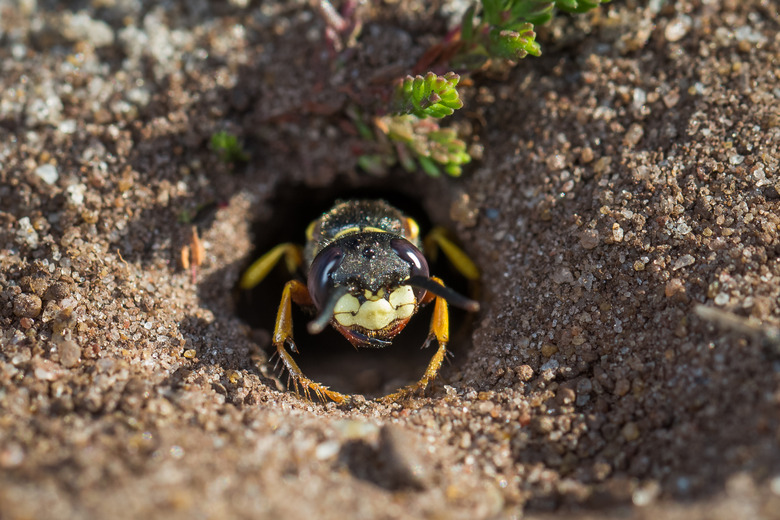How To Identify Ground Wasps
Many people know or have encountered — sometimes with painful results — large nests of certain communal wasp species, like the paper wasp, sometimes found in the rafters of old barns or porches. Some types of wasp species take to their shelter aerially, but others frequent burrows, tunnels, rotting bark, and other terrestrial hideaways. While it may be difficult to identify a ground-nesting specimen to its species, close inspection of anatomy and behavior — and a good insect guide — can sometimes point amateur, and brave, entomologists towards a specific species.
TL;DR (Too Long; Didn't Read)
To discern a ground wasp species, check for colouration, size, body shape, and behavior.
Check for Coloration
Check for Coloration
Look at the wasp's coloration. Many species of yellow jackets, a grouping of wasps that live in nest underground, can be distinguished by the bold pattern of black and yellow or white stripes, running down their carapace. By contrast, the great golden digger wasp, another ground-nester, has a black and orange coloration in a less-intricate fashion. Other wasps may be not have such strikingly painted bodies, like the predominantly black tiphiid wasps.
(Wasp) Size Matters
(Wasp) Size Matters
Consider the wasp's size. Some scoliid wasps — commonly seen on lawns in parts of the United States — have bodies 3/4 of an inch long. Compare that with the cicada killer, one of the most impressive of the ground-nesting wasps. This solitary hunter may grow be two inches long. Cicada killers, as their name suggests, pose as formidable predators of cicadas. They will incapacitate their victims — which are often larger than themselves — and drag them into their subterranean burrows.
Body Shapes Differ Dramatically
Body Shapes Differ Dramatically
Compare the wasp's body shape to those of other wasp species. Cicada killers and yellow jackets have robust bodies with thick abdomens and thoraxes. Scoliid and tiphiid wasps have more slender frames. The burrowing wasps have even more slim bodies, with an ant-like head and thorax, long legs and a narrow, elongated, but bulbously-tipped abdomen.
Watch How They Act
Watch How They Act
Watch the wasp's behavior. Some species fly around in groups and interact. If this is the case, the species may be a communally nesting ground wasp, like a yellow jacket. These familiar wasps may nest together in the thousands, and react in coordinated aggression if someone disturbs their homes. Roughly resembling a honeybee (at least at a distance), yellow jackets remain active well into the fall, and, because some species seek out meat and decaying food at this time of year, this is when they most frequently interact with human beings. Many ground-nesting species, however, live solitary lives. The great golden digger wasp, for example, will rarely be seen massing in groups.
Warning
While most wasps are not aggressive, many can sting painfully. You should always keep a respectful distance and avoid disturbing the insects or their shelters.
Cite This Article
MLA
Shaw, Ethan. "How To Identify Ground Wasps" sciencing.com, https://www.sciencing.com/identify-ground-wasps-5896470/. 25 April 2018.
APA
Shaw, Ethan. (2018, April 25). How To Identify Ground Wasps. sciencing.com. Retrieved from https://www.sciencing.com/identify-ground-wasps-5896470/
Chicago
Shaw, Ethan. How To Identify Ground Wasps last modified March 24, 2022. https://www.sciencing.com/identify-ground-wasps-5896470/
